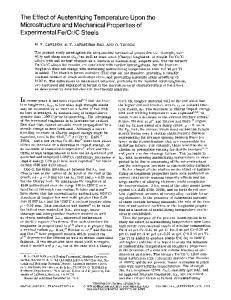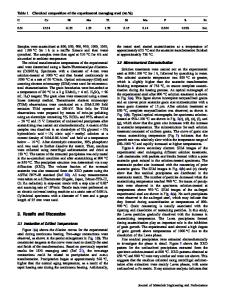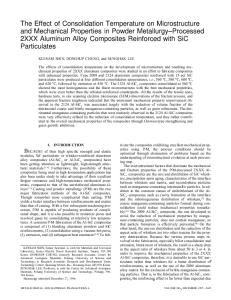The effect of austenitizing temperature on the microstructure and mechanical properties of as-quenched 4340 steel
- PDF / 3,700,637 Bytes
- 8 Pages / 612 x 783.28 pts Page_size
- 70 Downloads / 368 Views
R. A. CLARK,
V. F. ZACKAY,
AND
E. R. PARKER
The effect of austenitizing t e m p e r a t u r e on both the plane s t r a i n f r a c t u r e toughness, Klc, and the m t c r o s t r u c t u r e of AISI 4340 was studied. Austenitizing t e m p e r a t u r e s of 870 and 1200~ were employed. All s p e c i m e n s austenitized at 1200~ were furnace cooled f r o m the higher austenitizing t e m p e r a t u r e and then oil quenched from 870~ Transmission e l e c t r o n m i c r o s c o p y r e v e a l e d an apparent l a r g e i n c r e a s e in the amount of r e t a i n e d a u s t e n ite p r e s e n t in the s p e c i m e n s a u s t e n i t i z e d at the higher t e m p e r a t u r e . Austenitizing at 870~ r e s u l t e d in v i r t u a l l y no r e t a i n e d austenite; only minor amounts were found s p a r s e l y s c a t t e r e d in those a r e a s examined. A c o n s i d e r a b l y a l t e r e d m i c r o s t r u c t u r e was o b s e r v e d in s p e c i m e n s a u s t e n i t i z e d at 1200~ F a i r l y continuous 100 to 200~, thick films of r e t a i n e d austenite were o b s e r v e d between the m a r t e n s i t e laths throughout most of the a r e a e x a m ined. Additionally, s p e c i m e n s a u s t e n i t i z e d at 870~ contained twinned m a r t e n s t t e plates while those a u s t e n i t i z e d at 1200~ showed no twinning. Plane s t r a i n f r a c t u r e toughness m e a s u r e m e n t s exhibited an a p p r o x i m a t e 80 pct i n c r e a s e in toughness for s p e c i m e n s a u s t e n itized at 1200~ c o m p a r e d to those a u s t e n i t i z e d at 870~ The yield strength was unaffected by austenitizing t e m p e r a t u r e . The possible r o l e of r e t a i n e d austenite and the elimination of twinned m a r t e n s i t e in the enhancement of the f r a c t u r e toughness of those s p e c i m e n s a u s t e n itized at the higher t e m p e r a t u r e will be d i s c u s s e d .
MosT
of the quenched and t e m p e r e d low alloy s t e e l s in c u r r e n t use were developed decades ago by a b a s i c a l l y t r i a l and e r r o r approach. At high s t r e n g t h s (i.e., over 200,000 psi), these s t e e l s exhibit r e l a t i v e l y low f r a c t u r e toughness. Advancements in m e t a l l u r g i c a l techniques since the time these alloys were f i r s t introduced have been wide ranging. The p r o f e s s i o n is now capable of p r e c i s e l y r e l a t i n g alloy m i c r o s t r u c t u r e to mechanical p r o p e r t i e s . Recent studies have shown that u n d e s i r a b l e m i c r o s t r u c t u r a l f e a t u r e s in a s e c o n d a r y hardening 5 Mo0.3 C s t e e l can be m i n i m i z e d through austenitizing at a higher t e m p e r a t u r e . 1 The r e s u l t of this m i c r o s t r u c rural Improvement was a much higher f r a c t u r e toughness. In other investigations the f r a c t u r e toughness of s e v e r a l u l t r a high strength s t e e l s was improved by a) the elimination of twinned m a r t e n s l t e p l a t e s z,3 an
Data Loading...











